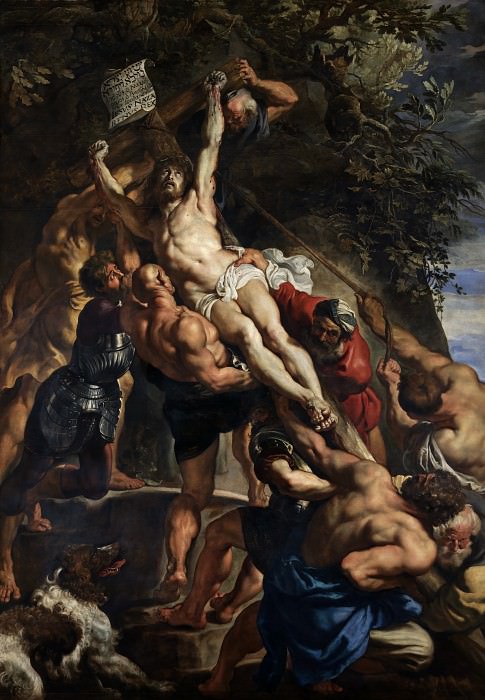Raising of the Cross * Peter Paul Rubens (1577-1640)
Peter Paul Rubens (Detail) – Raising of the Cross
Edit attribution
Download full size: 4011×5793 px (3,5 Mb)
Painter: Peter Paul Rubens
Peter Powell Rubens took up painting early. He learned from the works of Raphael, Titian, and Caravaggio. However, even his early paintings are innovative, combining Italian Renaissance painting with realistic national art. Rubens chose the glorification of life and religious themes as the main content of his works. The latter were in demand by the state, were written to order, and today decorate the altars of famous churches. "Exaltation of the Cross" (1609-1610) is a triptych painted by the artist quite quickly, given the size of the work.
Description of Peter Rubens’ painting of the Exaltation of the Cross
Peter Powell Rubens took up painting early. He learned from the works of Raphael, Titian, and Caravaggio. However, even his early paintings are innovative, combining Italian Renaissance painting with realistic national art.
Rubens chose the glorification of life and religious themes as the main content of his works. The latter were in demand by the state, were written to order, and today decorate the altars of famous churches.
"Exaltation of the Cross" (1609-1610) is a triptych painted by the artist quite quickly, given the size of the work. The total length of the canvas is 6.4 m!
The central part of the triptych is devoted to the execution of Jesus. But we see not the execution itself, but the process. Composition "Exaltation of the Cross" is large-scale, it is dominated by a complex rhythm, dynamic figures, widely used the play of light and shadow. Rubens is distinguished from other artists by his skillful combination of colors, which seem to breathe life into the painted pictures.
The impression of watching the subject is as if you can feel every muscle of the men straining to lift the tree with their bodies. Their poses are dynamic, their muscles play with power, and their faces are painted clearly and vividly. You can tell by the expressions in their eyes that they are trying and satisfied with the progress of the installation of the cross.
The figure of Jesus is painted masterfully, highlighted with light, as if to counterbalance the black and red robes of the tyrants. Rubens broke up the isolation of the individual images; his composition is harmonious, there are no freestanding heroes. The right and left parts of the painting are interconnected.
On the left, the grieving women, together with Mary and Joseph, pray for the salvation of Jesus. On the right are preparations for the execution of two criminals surrounded by several soldiers.
In this way, Rubens showed us a continual movement, an ever-changing universe where each of us makes a choice either for good or for evil.
Кому понравилось
Пожалуйста, подождите
На эту операцию может потребоваться несколько секунд.
Информация появится в новом окне,
если открытие новых окон не запрещено в настройках вашего браузера.
You need to login
Для работы с коллекциями – пожалуйста, войдите в аккаунт (open in new window).









![Peter Paul Rubens - Equestrian portrait of King Philip IV of Spain [circle]](http://cdn.gallerix.asia/j/_EX/754398988/2948910682.webp)










You cannot comment Why?
In this dramatic painting, we witness a powerful depiction of the Raising of the Cross. The central figure, Christ, is shown in the throes of crucifixion, his body pale and contorted as he is lifted onto the cross. He is surrounded by a group of muscular men, straining with all their might to raise the heavy wooden beam. Their faces are contorted with effort, and their bodies are taut with exertion. The scene is set against a dark, brooding background of trees and sky, which accentuates the intensity of the human drama unfolding.
The painting is rich with subtexts, conveying multiple layers of meaning:
Overall, the painting is a masterful portrayal of a sacred event, brimming with dramatic tension, human struggle, and profound theological and emotional resonance.